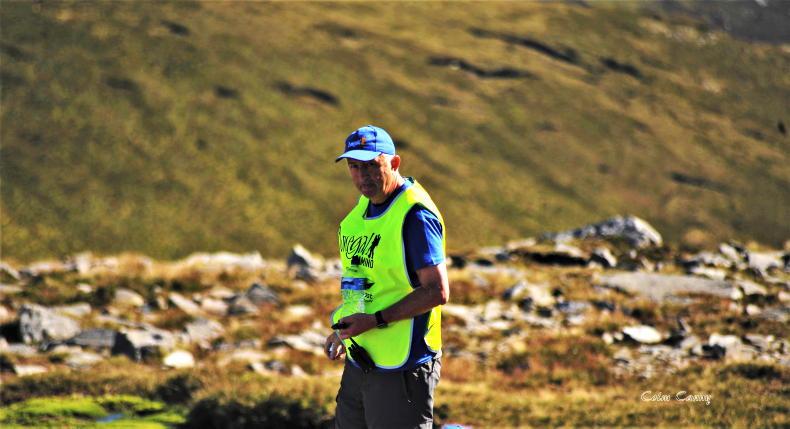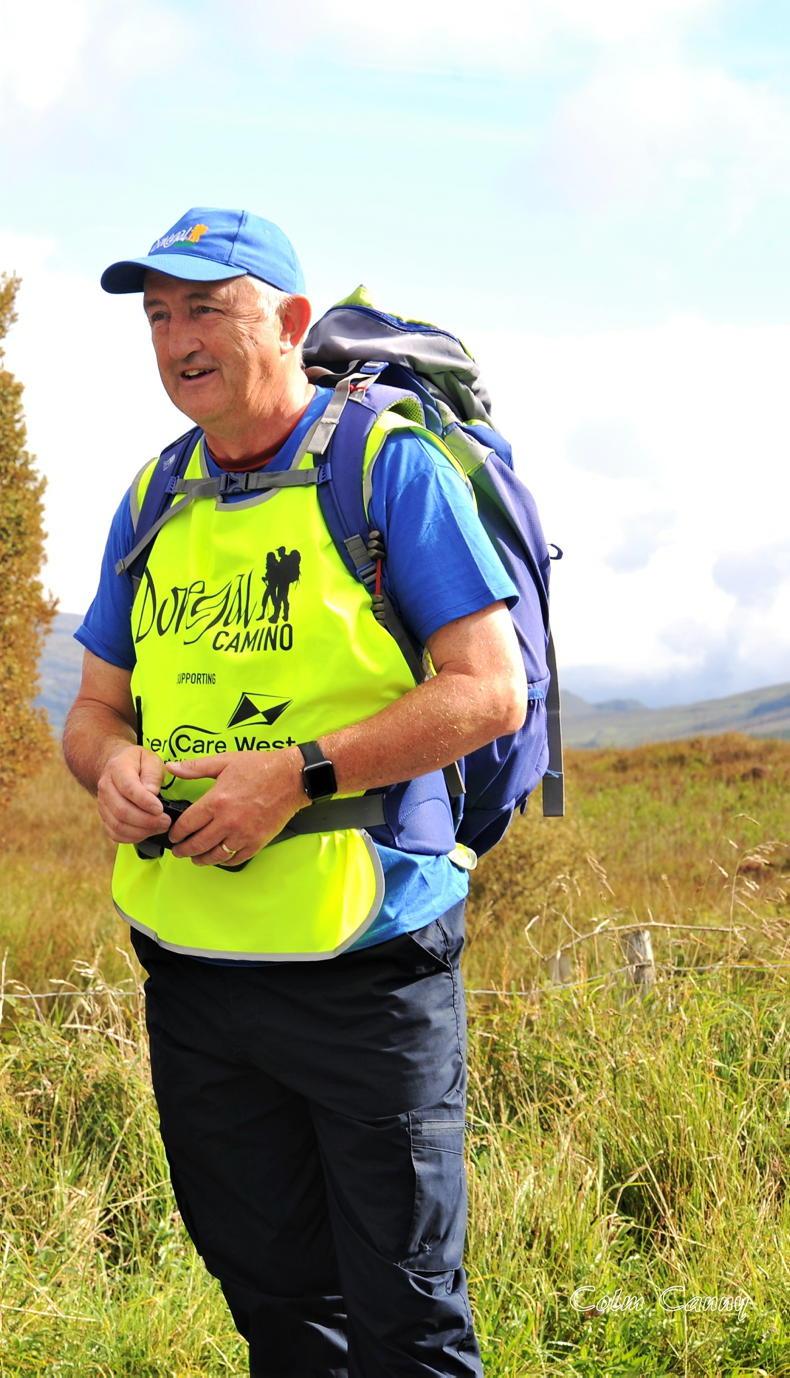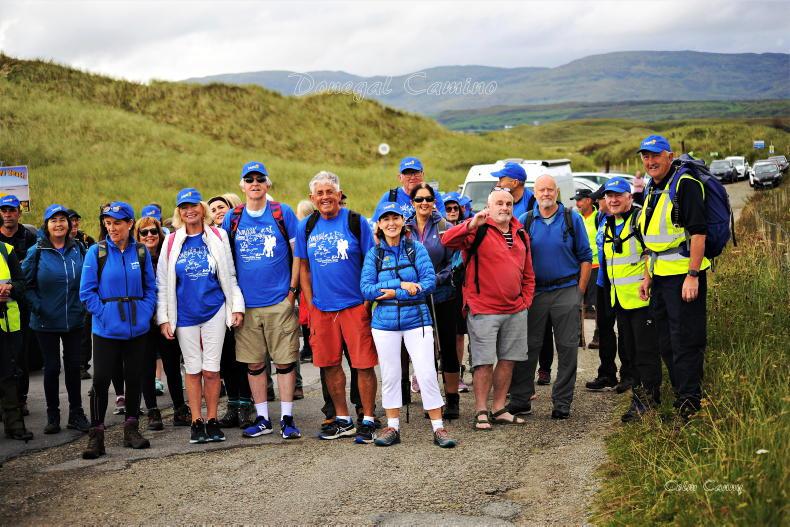Near midnight on 31 January 1944, seven lives were lost when a British flying boat crashed into the Blue Stack Mountains in Co Donegal. Five survived.
Many years later, a friend of John Mc Groary’s asked him did he know where the crash site was. John admits to Irish Country Living that despite growing up in the Blue Stacks, he “hadn’t a clue”. He did find out though and agreed to take a party of walkers in search of the wreckage. About 60 people turned up, almost half of them kids.
“We hadn’t a clue what we were at,” he says, once again acknowledging his lack of experience at the time. “We didn’t get to the aeroplane. It was a bit of a disaster but what it did do was it gave a few of us friends, the incentive to have a serious look at getting involved in hiking and hill walking.”
This group of friends started a club – the Ramblers, and did their mountain skills training. John himself went on to do mountain leadership but this was still all part-time while he worked as a member of An Garda Síochána.

In the early noughties, over two years, one night a week, the club completed the marine and countryside guiding badge through the Letterkenny Institute of Technology (now Atlantic Technical University) and the tourism college at Killybegs. Once qualified, “down the county” clubs started to ask the Ramblers to guide them in the Blue Stacks or Errigal. With this, John started to contemplate that perhaps being involved in tourism was not beyond the realms of possibility.
Cutting the blue cord
With 29 years’ experience in An Garda Síochána, John was seconded to Cyprus with the United Nations (UN).
“My job was as a liaison between the police in the north of Cyprus and the police in the south. That meant getting to know the whole UN buffer zone area. Towards the end of my year there, a delegation came from New York to inspect the mission. I got the job of going up on the chopper and showing them everything in the buffer zone. The thought struck me, ‘I’m actually a tour guide here.’”
On his return, John knew that if he didn’t follow his dream and “stayed on till I was 60” he was not really going to do anything else, so he pulled the plug and got out. That was July 2016 and while the plan was to focus on being ready for the 2017 season, the week after he retired, he was asked to run a bus tour. More followed, John bought his own minibus and his company Walking Ireland went from there.

There’s two different sides to John’s tours – a hiking side and the sightseeing side. Unsurprisingly he will always encourage his groups to spend two or three days in Donegal. Although his personal highlights include Slieve League, Malin Head and Glenveigh National Park, visitors, he says, “are amazed at the quality of [Irish] beaches. They are also amazed that people go into the water.”
Tourism potential
The Blue Stack Way and a couple of other trails have been joined together to create the 123km Donegal element of the International Appalachian Trail. A product, John believes, has massive hiking potential, particularly for the international market. Recognition and growth of Donegal as a hiking destination is increasing but it’s slow, he laments.
“There are reasons it’s slow. I suppose over the years of the Troubles in Northern Ireland, people were reluctant to come here but certainly since I started this business, we’ve seen numbers increasing. Like everywhere, COVID didn’t help matters at all.”

However, it had its upside also. “Without a doubt, it made Irish people more conscious of their surroundings but it also made the Government realise that they have to invest in an infrastructure for outdoor activities.”
The type of infrastructure John alludes to includes the new roadway between Glenties and Dungloe which will have a cycling and hiking path. When finished, it will be possible to walk from Donegal town all the way to Tory Island. Most of those developments are on country laneways but some go through private lands and are negotiated trails.
Mountain development
Many come, American and Irish predominantly, for a week’s hiking and they want to take on the big ones like Slieve League. There are some considerations for John in planning these trips, he explains: “Although it’s not as tough as Croagh Patrick, it does require care. It has had some development and there’s a study being done in relation to what other development is required in terms of paths.”

Are paths a good idea? I ask, having heard that many are neither in favour of a path or a scar from traffic. John’s response: “It depends. Take Errigal, €700,000 has been invested in the path. Errigal was an environmental disaster prior to the path. So, do you give up a little bit of the area to make a path and save the rest of it? Already I see massive improvement in relation to the flora and fauna.”
The first part of the Errigal path opened in June and John has already seen the eroded areas starting to show signs of heather growth and Bog asphodel.
“It’s a double-edged sword,” he says. “People are going to come anyway, so you’re probably better putting in a path and keeping people in an area rather than letting them wander everywhere.”
http://www.walkingireland.ie/
Donegal
Camin0
John guides the Donegal Camino which this year raised €50,500 for Cancer Care West Services in Donegal. The 2023 Camino will take place 3-9 September with details of the route, walks and fundraising plans announced in the new year. www.donegalcamino.ie
Read more
Cause it's another day for you and me in paradise
O’ the Hills of Donegal - stories and song on the northwest’s camino
Near midnight on 31 January 1944, seven lives were lost when a British flying boat crashed into the Blue Stack Mountains in Co Donegal. Five survived.
Many years later, a friend of John Mc Groary’s asked him did he know where the crash site was. John admits to Irish Country Living that despite growing up in the Blue Stacks, he “hadn’t a clue”. He did find out though and agreed to take a party of walkers in search of the wreckage. About 60 people turned up, almost half of them kids.
“We hadn’t a clue what we were at,” he says, once again acknowledging his lack of experience at the time. “We didn’t get to the aeroplane. It was a bit of a disaster but what it did do was it gave a few of us friends, the incentive to have a serious look at getting involved in hiking and hill walking.”
This group of friends started a club – the Ramblers, and did their mountain skills training. John himself went on to do mountain leadership but this was still all part-time while he worked as a member of An Garda Síochána.

In the early noughties, over two years, one night a week, the club completed the marine and countryside guiding badge through the Letterkenny Institute of Technology (now Atlantic Technical University) and the tourism college at Killybegs. Once qualified, “down the county” clubs started to ask the Ramblers to guide them in the Blue Stacks or Errigal. With this, John started to contemplate that perhaps being involved in tourism was not beyond the realms of possibility.
Cutting the blue cord
With 29 years’ experience in An Garda Síochána, John was seconded to Cyprus with the United Nations (UN).
“My job was as a liaison between the police in the north of Cyprus and the police in the south. That meant getting to know the whole UN buffer zone area. Towards the end of my year there, a delegation came from New York to inspect the mission. I got the job of going up on the chopper and showing them everything in the buffer zone. The thought struck me, ‘I’m actually a tour guide here.’”
On his return, John knew that if he didn’t follow his dream and “stayed on till I was 60” he was not really going to do anything else, so he pulled the plug and got out. That was July 2016 and while the plan was to focus on being ready for the 2017 season, the week after he retired, he was asked to run a bus tour. More followed, John bought his own minibus and his company Walking Ireland went from there.

There’s two different sides to John’s tours – a hiking side and the sightseeing side. Unsurprisingly he will always encourage his groups to spend two or three days in Donegal. Although his personal highlights include Slieve League, Malin Head and Glenveigh National Park, visitors, he says, “are amazed at the quality of [Irish] beaches. They are also amazed that people go into the water.”
Tourism potential
The Blue Stack Way and a couple of other trails have been joined together to create the 123km Donegal element of the International Appalachian Trail. A product, John believes, has massive hiking potential, particularly for the international market. Recognition and growth of Donegal as a hiking destination is increasing but it’s slow, he laments.
“There are reasons it’s slow. I suppose over the years of the Troubles in Northern Ireland, people were reluctant to come here but certainly since I started this business, we’ve seen numbers increasing. Like everywhere, COVID didn’t help matters at all.”

However, it had its upside also. “Without a doubt, it made Irish people more conscious of their surroundings but it also made the Government realise that they have to invest in an infrastructure for outdoor activities.”
The type of infrastructure John alludes to includes the new roadway between Glenties and Dungloe which will have a cycling and hiking path. When finished, it will be possible to walk from Donegal town all the way to Tory Island. Most of those developments are on country laneways but some go through private lands and are negotiated trails.
Mountain development
Many come, American and Irish predominantly, for a week’s hiking and they want to take on the big ones like Slieve League. There are some considerations for John in planning these trips, he explains: “Although it’s not as tough as Croagh Patrick, it does require care. It has had some development and there’s a study being done in relation to what other development is required in terms of paths.”

Are paths a good idea? I ask, having heard that many are neither in favour of a path or a scar from traffic. John’s response: “It depends. Take Errigal, €700,000 has been invested in the path. Errigal was an environmental disaster prior to the path. So, do you give up a little bit of the area to make a path and save the rest of it? Already I see massive improvement in relation to the flora and fauna.”
The first part of the Errigal path opened in June and John has already seen the eroded areas starting to show signs of heather growth and Bog asphodel.
“It’s a double-edged sword,” he says. “People are going to come anyway, so you’re probably better putting in a path and keeping people in an area rather than letting them wander everywhere.”
http://www.walkingireland.ie/
Donegal
Camin0
John guides the Donegal Camino which this year raised €50,500 for Cancer Care West Services in Donegal. The 2023 Camino will take place 3-9 September with details of the route, walks and fundraising plans announced in the new year. www.donegalcamino.ie
Read more
Cause it's another day for you and me in paradise
O’ the Hills of Donegal - stories and song on the northwest’s camino










 This is a subscriber-only article
This is a subscriber-only article










SHARING OPTIONS: